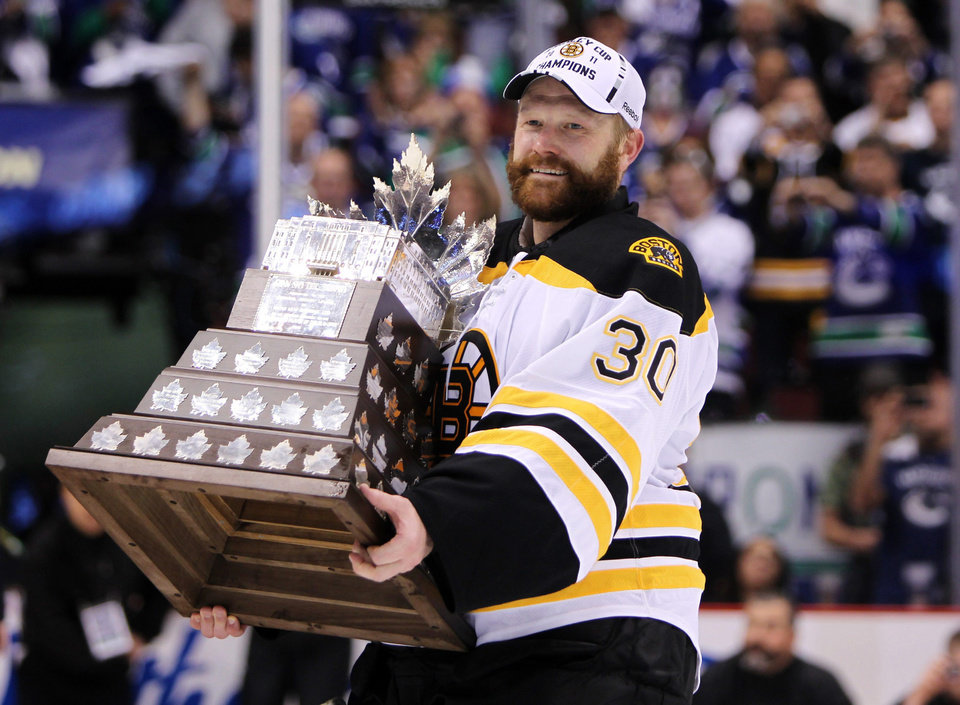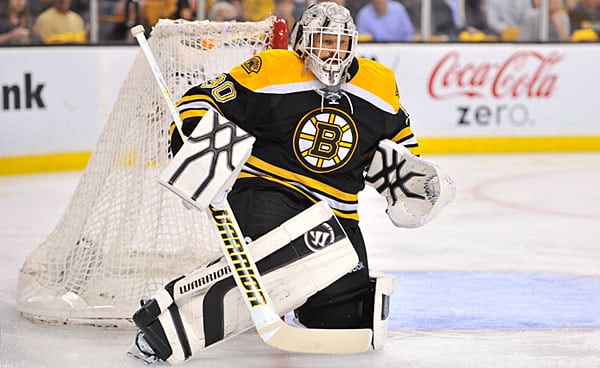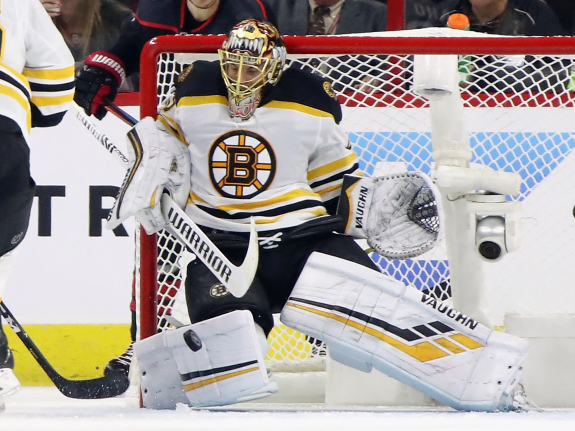
( Photo Credit: AP/The Canadian Press, Jonathan Hayward )
By Joe Chrzanowski | Follow Me on Twitter @jchrz19
Whenever hockey fans get together to discuss whether a certain player’s number should be retired, the conversation is bound to get hot and heavy. When that player happens to be a goaltender, the discussion seems to be even more heated than it normally is for some reason? I’m not sure whether it is as simple as because goalies wear such a limited range of jersey numbers (so people don’t want any retired) or because goaltending statistics seem so much harder to quantify than skaters who play out of the net?
Whatever the reason, there are only 17 goalie numbers that have been retired in the history of the NHL (Patrick Roy’s #33 is retired twice, for both the Canadiens and the Avalanche). The Bruins are the only Original Six franchise that does not have at least one netminder’s number hanging in the rafters. Toronto (Broda and Bower), New York (Giacomin and Richter), and Montreal (Roy and Plante), have two each. Detroit (Sawchuk) and Chicago (Esposito) have one apiece.
In recent months, with the NHL season suspended, many sports channels have taken to replaying past series and games in order to fill in the gaps left by the lack of hockey. NESN was no exception and they recently replayed the Bruins memorable Stanley Cup playoff run in 2011, highlighting Boston’s first championship since 1972. There were many key contributors during the run to the Cup, but the most valuable was deemed to be Tim Thomas. In 25 games, Thomas posted a .940 Save Percentage, a 1.98 GAA, and had four shutouts en route to winning the Conn Smythe Trophy as playoff MVP.
The recent re-airings of these Cup classics have people talking about Thomas again and many have brought up the question of whether or not Thomas’ #30 jersey is worthy of being raised to the Garden rafters. On the surface, it would appear that perhaps a goalie like Gerry Cheevers is just as/more deserving, and what about Tuukka Rask? Let’s take a deeper look at Thomas and some of the other potential candidates the B’s have to offer.

( Photo Credit: Brian Babineau/NHL via Getty Images )
Thomas is a pretty familiar story by now to most B’s fans. He played hockey for the University of Vermont (along with fellow future-NHLer Martin St. Louis), and was drafted in the 9th Round by the Quebec Nordiques, but was never signed by them. From 1997-98 through 2005-06 Thomas kicked around a number of leagues including the IHL, AHL, SHL, and Finnish Liiga before playing in the NHL for Boston. His season for Jokerit during the lockout in 2004-05 was what likely catapulted him to finally getting a legitimate NHL opportunity. With a lot of NHL talent playing in Finland that year, Thomas dominated the goaltender position playing 54 games with a 1.58 GAA and .946 save percentage during the regular season. In the playoffs, he was nearly as good with a 1.83 GAA and .938 save percentage, leading his team to the finals.
It must have been quite a transition in 2005-06 for Thomas to go from a European powerhouse to one of the worst teams in the NHL when he became a regular in Boston, and eventually took over the starting job from teammate Andrew Raycroft. The Bruins finished as the 5th worst team that year and 8th from the bottom the following season. Despite the horrible team in front of him, Thomas put up respectable numbers. The 2007-08 season would bring a number of changes, including new head coach Claude Julien, whose defensive style was much more “goalie-friendly” than the prior regime. Thomas’ stats would reflect that as the B’s returned to the playoffs.
From that year through 2011-12 (his last with the Bruins), Thomas was a monster in net for Boston, winning a Stanley Cup, a Conn Smythe, and two Vezina Trophies as the NHL’s best goaltender. He was, without a doubt, the league’s best during that period of time. During his eight years with the B’s, he played in 378 regular-season games, winning 196 with a 2.48 GAA and .921 save percentage. Generally speaking, those are fantastic numbers, and even more impressive when you add the hardware.
[youtube https://www.youtube.com/watch?v=9x6EIgoAtjs&w=560&h=315]
The knock against Thomas (when you are talking about retiring his number) is and has always been his longevity. He did not become a regular in the NHL until the age of 31, and while he made up for his lack of quantity in the league with a great deal of quality, there are people who will always hold this against him. If you want to compare him to some peers, he’s middle to the low end of the pack for NHL games played. Of course, that was out of his control to a large extent due to circumstances.
The two names that I hear mentioned the most in comparison to Thomas when it comes to potentially retiring numbers are Gerry Cheevers and Tuukka Rask. Of the two, the far easier comparison is Rask, because he played in the same era as Thomas. It is extremely difficult to compare players from two different eras and even more so when it comes to the goaltender position because the position has evolved more than any other in the game in my opinion.
In these situations, I think the only fair thing to do is to look at the player’s stats and rankings among their peers of that era. In my opinion, this is a far more relevant way of looking at it, as opposed to just comparing the two players, regardless of when they played. Cheevers played a total of 418 games (171 in the 60’s, 247 in the ’70s) over an NHL career that spanned 13 years (compared to nine for Thomas). If this seems a little low, it’s probably because Cheesy left the B’s for four years in the mid-’70s to play in the newly formed WHA, registering nearly 200 games there.

( Photo Credit: Bruce Bennett/Getty Images )
When you dig a little deeper, Cheevers ranked 14th for games played in the 1960s. His 2.97 GAA was good for 19th place, while his .907 save percentage placed him 18th. If we do the same for the 1970s, he is 23rd for games played, 14th for goals-against average (2.97), and 23rd for save percentage (.895). Personally, I tend to look more closely at the save percentage numbers because goals against can be reflective of the strength of the team in front of a goalie. To be perfectly honest, before I started this article, I expected Cheever’s stats to be better than they were, relative to his era. In his defense, if he had stayed with the Bruins, the four years he was in the WHA likely would have been some of his best and bolstered his numbers considerably. For intangibles, Cheevers has two Stanley Cups, including the first in 29 years for the B’s in 1970.
Thomas’ teammate Tuukka Rask is a much easier comparison when it comes to the numbers. Through this year, Rask’s career has spanned 13 seasons and he has played in 536 games (50 in the 2000s and 486 in the 2010s), surpassing both Cheevers and Thomas. His statistics are impressive when compared to his peers. Just looking at this decade, Rask is 1st in GAA (100 games or more), with a 2.29 mark and 2nd for save percentage at .921 over a span of almost 500 games. The only black mark over this period (and it’s huge for some) is that he has been unable to lead Boston to a Cup as a starter, losing in the Finals in both 2013 and 2019.
If we do the same for Tim Thomas at his stats for his era, they are very good for the most part. His 2.61 GAA in the 2000s was 35th among goalies with more than 100 games played. I think this number is largely reflective of the two years the Bruins were awful when he became a regular. His save percentage (.918) is much better placing 8th. In the 2010’s his 2.38 GAA is good for 4th and his .924 save percentage is 1st (ahead of Rask).

( Photo Credit: Bruce Bennett/Getty Images )
We have looked at three goalies and to me, they represent three different situations. Cheevers has the worst stats by far among his peers, but he has the most Cups with two and has four prime years missing to the WHA. Thomas has very good numbers in his era, along with a lot of hardware (one Cup, one Conn Smythe, and two Vezinas). Rask has the best statistics of the three men, also has a Vezina Trophy, but lacks a Stanley Cup.
I can see why some Bruins fans think that Cheevers number 30 should be retired (he also wore 31 earlier in his career), despite the lack of great stats. I can also see why a lot of B’s faithful think that Thomas’ number 30 should be retired (obviously problematic) despite his lack of longevity. This may be somewhat controversial, but I don’t believe either of those guys should have their numbers raised to the rafters. If I had to choose one, it would be Rask, who has been statistically the most dominant goalie of this decade, despite him not having a Cup. I say this because in both playoff runs where he went to the finals, Rask has been nothing short of phenomenal (1.88 GAA, .940 Save% in 2013 and 2.02/.934 in 2019). He could not close either series out, but the Bruins don’t get there if not for Rask in both instances. Agree? Disagree? That’s why discussing sports is so much fun.
( I want to thank both QuantHockey and Hockey Reference for their invaluable statistics)
Check out the new Black N’ Gold Hockey Podcast episode 181 that we recorded below on 5-31-20! You can find our show on many worldwide platforms such as Apple Podcasts, Google Podcasts, iHeart Radio, Spotify, SoundCloud, and Stitcher!
[soundcloud url=”https://api.soundcloud.com/tracks/831855253″ params=”color=#ff5500&auto_play=false&hide_related=false&show_comments=true&show_user=true&show_reposts=false&show_teaser=true&visual=true” width=”100%” height=”450″ iframe=”true” /]Please subscribe to our new Black N’ Gold Hockey YouTube channel! We’d really appreciate the continued support. Click HERE for exciting Black N’ Gold online content!


0 Comments
1 Pingback